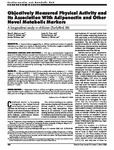Objectively Measured Physical Activity and Its Association With Adiponectin and Other Novel Metabolic Markers
| dc.contributor.author | Metcalf, BS | |
| dc.contributor.author | Jeffery, Alison | |
| dc.contributor.author | Hosking, Joanne | |
| dc.contributor.author | Voss, LD | |
| dc.contributor.author | Sattar, N | |
| dc.contributor.author | Wilkin, TJ | |
| dc.date.accessioned | 2018-03-26T13:46:02Z | |
| dc.date.available | 2018-03-26T13:46:02Z | |
| dc.date.issued | 2009-03-01 | |
| dc.identifier.issn | 0149-5992 | |
| dc.identifier.issn | 1935-5548 | |
| dc.identifier.uri | http://hdl.handle.net/10026.1/11173 | |
| dc.description.abstract |
<jats:p>OBJECTIVE—Recent evidence suggests that, in children, traditional markers of metabolic disturbance are related only weakly to physical activity. We therefore sought to establish the corresponding relationships with newer metabolic markers.</jats:p> <jats:p>RESEARCH DESIGN AND METHODS—This was a nonintervention longitudinal study of 213 healthy children recruited from 54 schools in Plymouth, U.K. MTI accelerometers were used to make objective 7-day recordings of physical activity at ages 5 ± 0.3 (mean ± SD), 6, 7, and 8 years. Overall physical activity was taken as the average of the four annual time points. The metabolic markers at 8 years were adiponectin, leptin, high-sensitivity C-reactive protein (hsCRP), and insulin resistance (homeostasis model assessment). Potential confounders included percent body fat measured by dual-energy X-ray absorptiometry and diet measured by food frequency questionnaire.</jats:p> <jats:p>RESULTS—Whereas physical activity did not correlate with insulin resistance (r = −0.01), leptin (r = +0.04), or hsCRP (r = +0.01) independently of percent body fat, it did correlate with adiponectin, but inversely (r = −0.18, P = 0.02). This unexpected inverse relationship was strongest among the less active children (physical activity &lt; median: r = −0.30, P = 0.01) but negligible in the more active children (physical activity &gt; median: r = +0.04, P = 0.76). Adiponectin was significantly higher (0.52 SD, P &lt; 0.01) in the least active tertile compared with the other two tertiles. Insulin resistance, however, did not differ across the physical activity tertiles (P = 0.62).</jats:p> <jats:p>CONCLUSIONS—Adiponectin levels in children are highest among those who are least active, but their insulin resistance is no different. Adiponectin has a known insulin-sensitizing effect, and our findings are consistent with a selective effect at low levels of physical activity.</jats:p> | |
| dc.format.extent | 468-473 | |
| dc.format.medium | Print-Electronic | |
| dc.language.iso | en | |
| dc.publisher | American Diabetes Association | |
| dc.subject | Absorptiometry, Photon | |
| dc.subject | Adiponectin | |
| dc.subject | C-Reactive Protein | |
| dc.subject | Child | |
| dc.subject | Child, Preschool | |
| dc.subject | Female | |
| dc.subject | Humans | |
| dc.subject | Insulin Resistance | |
| dc.subject | Leptin | |
| dc.subject | Longitudinal Studies | |
| dc.subject | Male | |
| dc.subject | Motor Activity | |
| dc.title | Objectively Measured Physical Activity and Its Association With Adiponectin and Other Novel Metabolic Markers | |
| dc.type | conference | |
| dc.type | Journal Article | |
| dc.type | Research Support, Non-U.S. Gov't | |
| plymouth.author-url | https://www.webofscience.com/api/gateway?GWVersion=2&SrcApp=PARTNER_APP&SrcAuth=LinksAMR&KeyUT=WOS:000264060400020&DestLinkType=FullRecord&DestApp=ALL_WOS&UsrCustomerID=11bb513d99f797142bcfeffcc58ea008 | |
| plymouth.issue | 3 | |
| plymouth.volume | 32 | |
| plymouth.publication-status | Published | |
| plymouth.journal | Diabetes Care | |
| dc.identifier.doi | 10.2337/dc08-1329 | |
| plymouth.organisational-group | /Plymouth | |
| plymouth.organisational-group | /Plymouth/Faculty of Health | |
| plymouth.organisational-group | /Plymouth/Faculty of Health/Peninsula Medical School | |
| plymouth.organisational-group | /Plymouth/REF 2021 Researchers by UoA | |
| plymouth.organisational-group | /Plymouth/REF 2021 Researchers by UoA/UoA03 Allied Health Professions, Dentistry, Nursing and Pharmacy | |
| plymouth.organisational-group | /Plymouth/Research Groups | |
| plymouth.organisational-group | /Plymouth/Research Groups/Institute of Translational and Stratified Medicine (ITSMED) | |
| plymouth.organisational-group | /Plymouth/Research Groups/Institute of Translational and Stratified Medicine (ITSMED)/CBBB | |
| plymouth.organisational-group | /Plymouth/Research Groups/Institute of Translational and Stratified Medicine (ITSMED)/CCT&PS | |
| plymouth.organisational-group | /Plymouth/Research Groups/Plymouth Institute of Health and Care Research (PIHR) | |
| plymouth.organisational-group | /Plymouth/Users by role | |
| plymouth.organisational-group | /Plymouth/Users by role/Academics | |
| dc.publisher.place | United States | |
| dc.identifier.eissn | 1935-5548 | |
| dc.rights.embargoperiod | No embargo | |
| rioxxterms.versionofrecord | 10.2337/dc08-1329 | |
| rioxxterms.licenseref.uri | http://www.rioxx.net/licenses/all-rights-reserved | |
| rioxxterms.type | Conference Paper/Proceeding/Abstract |


